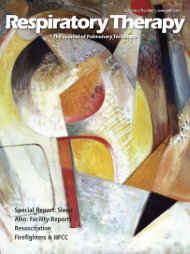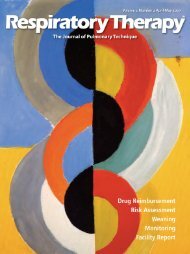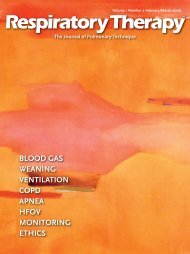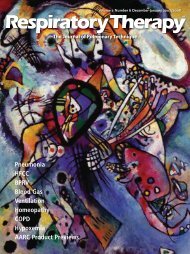RT 02-03 JJ07 main web - Respiratory Therapy Website
RT 02-03 JJ07 main web - Respiratory Therapy Website
RT 02-03 JJ07 main web - Respiratory Therapy Website
You also want an ePaper? Increase the reach of your titles
YUMPU automatically turns print PDFs into web optimized ePapers that Google loves.
OSAS in children. 55 Although there are currently gaps in the<br />
evidence, the following is suggested as an approach to the<br />
recognition of OSAS in children:<br />
(1) The possibility of obstructive sleep apnea should be<br />
considered in children with habitual snoring, although the<br />
majority of these children will have primary snoring. Although<br />
clinical assessment is poor at discriminating primary snoring<br />
from OSAS, symptoms or signs suggestive of the latter should<br />
prompt further investigation. In the presence of significant<br />
complications, such as cardiorespiratory failure, investigation<br />
should be urgent in a specialist center.<br />
(2) Single channel systems, such as overnight oximetry, may be<br />
helpful if they show positive results in the context of a<br />
suggestive history of uncomplicated OSAS. However, a normal<br />
study does not exclude OSAS and polysomnography re<strong>main</strong>s the<br />
gold standard investigation. Unattended home studies using<br />
multichannel systems appear promising and deserve further<br />
evaluation in this context.<br />
(3) Complex and high risk patients, such as those with<br />
craniofacial abnormalities, neuromuscular disorders, and<br />
suspected central hypoventilation, should be referred to a<br />
specialist centre for further investigation.<br />
References<br />
1 Owens JA. The practice of pediatric sleep medicine: results<br />
of a community survey. Pediatrics 2001;108:e51.<br />
2 Archbold KH, Pituch KJ, Panahi P, et al. Symptoms of sleep<br />
disturbances among children at two general pediatric clinics.<br />
J Pediatr 20<strong>02</strong>;140:97–1<strong>02</strong>.<br />
3 Mograss MA, Ducharme FM, Brouillette <strong>RT</strong>.<br />
Movement/arousals. Description, classification and<br />
relationship to sleep apnea in children. Am J Respir Crit<br />
Care Med 1994;150:1690–6.<br />
4 Baharav A, Kotagal S, Rubin BK, et al. Autonomic<br />
cardiovascular control in children with obstructive sleep<br />
apnea. Clin Auton Res 1999;9:345–51.<br />
5 Brooks LJ, Topol HI. Enuresis in children with sleep apnea. J<br />
Pediatr 20<strong>03</strong>;142:515–18.<br />
6 Carroll JL, Loughlin GM. Diagnostic criteria for obstructive<br />
sleep apnea syndrome in children. Pediatr Pulmonol<br />
1992;14:71–4.<br />
7 Dahl RE. The impact of inadequate sleep on children’s<br />
daytime cognitive function. Semin Pediatr Pulmonol<br />
1996;3:44–55.<br />
8 Gozal D. Sleep disordered breathing and school performance<br />
in children. Pediatrics 1998;1<strong>02</strong>:616–20.<br />
9 Urschitz MS, Guenter A, Eggebrecht E, et al. Snoring,<br />
intermittent hypoxia and academic performance in primary<br />
schoolchildren. Am J Respir Crit Care Med 20<strong>03</strong>;168:464–8.<br />
10 Perkins JA, Sie KCY, Milczuk H, et al. Airway management in<br />
children with craniofacial abnormalities. Cleft Palate<br />
Craniofac J 1997;34:135–40.<br />
11 Mogayzel PJ, Carroll JL, Loughlin GM, et al. Sleep disordered<br />
breathing in children with achondroplasia. J Pediatr<br />
1998;132:667–71.<br />
12 Rose E, Thissen U, Otten JE, et al. Cephalometric<br />
assessment of the posterior airway space in patients with<br />
cleft palate after palatoplasty. Cleft Palate Craniofac J<br />
20<strong>03</strong>;40:498–5<strong>03</strong>.<br />
13 Brouillette <strong>RT</strong>, Fernbach SK, Hunt CE. Obstructive sleep<br />
apnea in infants and children. J Pediatr 1982;100:31–40.<br />
14 Marcus CL, Greene MG, Carroll JL. Blood pressure in<br />
children with obstructive sleep apnea. Am J Respir Crit Care<br />
Med 1998;157:1098–1<strong>03</strong>.<br />
15 Enright PL, Godwin JL, Sherril DL, et al. Blood pressure<br />
elevation associated with sleep related breathing disorder in<br />
a community sample of white and Hispanic children: the<br />
Tucson Children’s Assessment of Sleep Apnea Study. Arch<br />
Pediatr Adolesc Med 20<strong>03</strong>;157:901–4.<br />
16 Ali NJ, Stradling JR. Epidemiology and natural history of<br />
snoring and sleepdisordered breathing in children. In:<br />
Loughlin GM, Carroll JL, Marcus CL, eds. Sleep and<br />
breathing in children. A developmental approach. New York:<br />
Marcel Dekker, 2000.<br />
17 Brouillette R, Hanson D, David R, et al. A diagnostic<br />
approach to suspected obstructive sleep apnea in children. J<br />
Pediatr 1984;105:10–14.<br />
18 Carroll JL, McColley SA, Marcus CL, et al. Inability of<br />
clinical history to distinguish primary snoring from<br />
obstructive sleep apnea syndrome in children. Chest<br />
1995;108:610–18.<br />
19 Preutthipan A, Chantarojanasiri T, Suwanjutha S, et al. Can<br />
parents predict the severity of childhood obstructive sleep<br />
apnea? Acta Pediatr 2000;89:708–12.<br />
20 Wang RC, Elkins TP, Keech D, et al. Accuracy of clinical<br />
evaluation in pediatric obstructive sleep apnea. Otolaryngol<br />
Head Neck Surg 1998;118:69–73.<br />
21 Suen JS, Arnold JE, Brooks JL. Adenotonsillectomy for<br />
treatment of obstructive sleep apnea in children. Arch<br />
Otolarngol Head Neck Surg 1995;121:525–30.<br />
22 Marcus CL, Keens TG, Ward SL. Comparison of nap and<br />
overnight polysomnography in children. Pediatr Pulmonol<br />
1992;13:16–21.<br />
23 Biban P, Baraldi E, Pettennazzo A, et al. Adverse effects of<br />
chloral hydrate in two young children with obstructive sleep<br />
apnea. Pediatrics 1993;92:461–3.<br />
24 Kohyama J, Shiiki T, Shimohira M, et al. Asynchronous<br />
breathing during sleep. Arch Dis Child 2001;84:174–7.<br />
25 Shimada T, Shiina T, Saito Y. Detection of characteristic<br />
waves of sleep EEG by neural network analysis. IEEE Trans<br />
Biomed Eng 2000;47:369–79.<br />
26 Stradling JR, Thomas G, Warley AR, et al. Effect of<br />
adenotonsillectomy on hypoxaemia, sleep disturbance and<br />
symptoms in snoring children. Lancet 1990;335:249–53.<br />
27 Brouillette <strong>RT</strong>, Morielli A, Leimanis A, et al. Nocturnal pulse<br />
oximetry as an abbreviated testing modality for pediatric<br />
obstructive sleep apnea. Pediatrics 2000;105:405–12.<br />
28 Rosen CL, D’Andrea L, Haddad GG. Adult criteria for<br />
obstructive sleep apnea do not identify children with serious<br />
obstruction. Am Rev Respir Dis 1992;146:1231–4.<br />
29 Guilleminault C, Pelayo R, Leger D, et al. Recognition of<br />
sleep disordered breathing in children. Pediatrics<br />
1996;98:871–82.<br />
30 Rosen GM, Muckle RP, Mahowald MW, et al. Postoperative<br />
respiratory compromise in children with obstructive sleep<br />
apnea: can it be anticipated? Pediatrics 1994;93:784–8.<br />
31 White JE, Smithson AJ, Close PR, et al. The use of sound<br />
recording and oxygen saturation in screening snorers for<br />
obstructive sleep apnea. Clin Otolarngol 1994;19:218–21.<br />
32 Goldstein NA, Sculerati N, Walsleben JA, et al. Clinical<br />
diagnosis of pediatric obstructive sleep apnea validated by<br />
polysomnography. Otolaryngol Head Neck Surg<br />
1994;111:611–17.<br />
33 Lamm C, Mandeli J, Kattan M. Evaluation of home<br />
audiotapes as an abbreviated test for obstructive sleep<br />
<strong>Respiratory</strong> <strong>Therapy</strong> Vol. 2 No. 3 � June-July 2007 75











